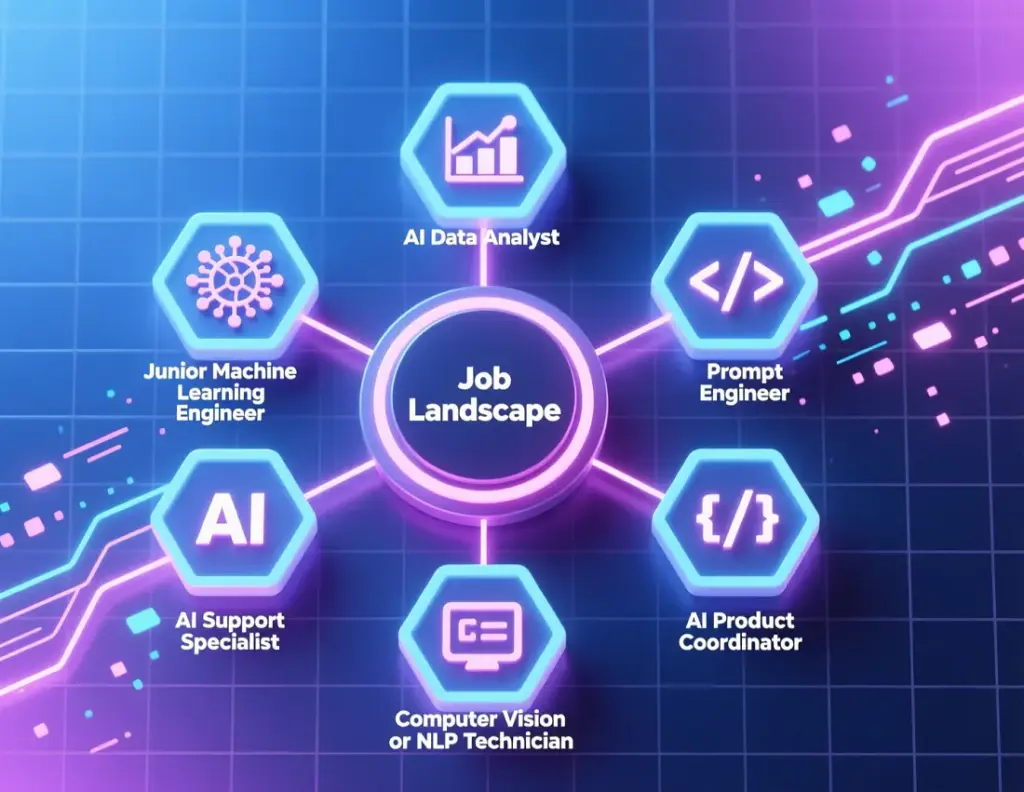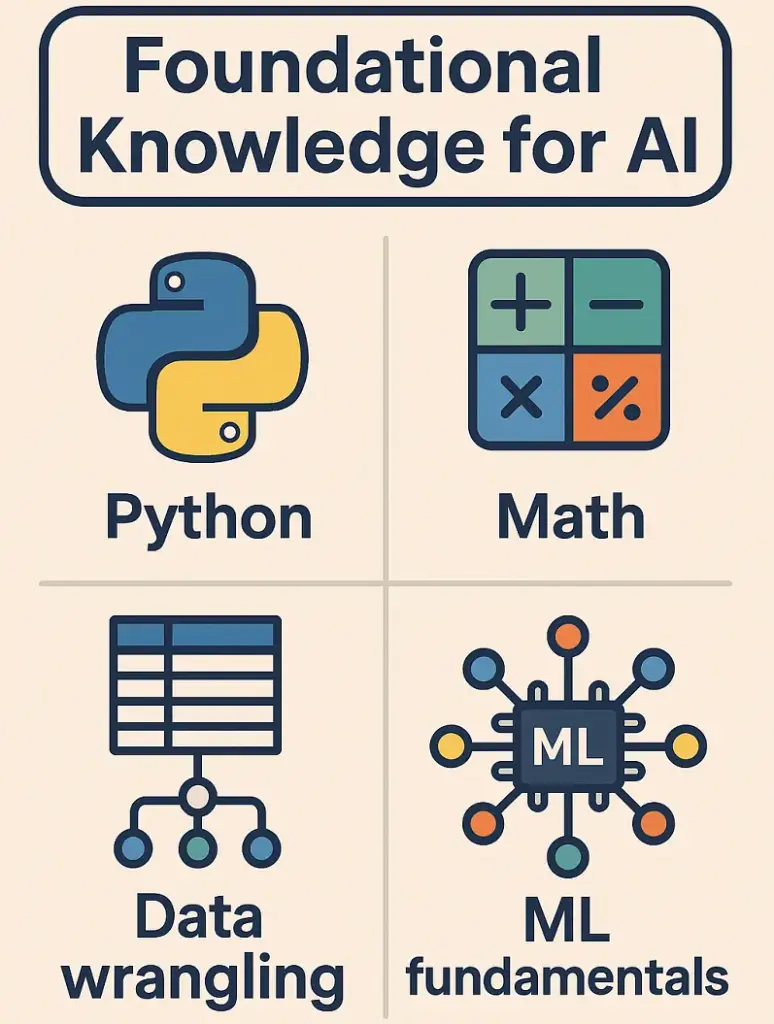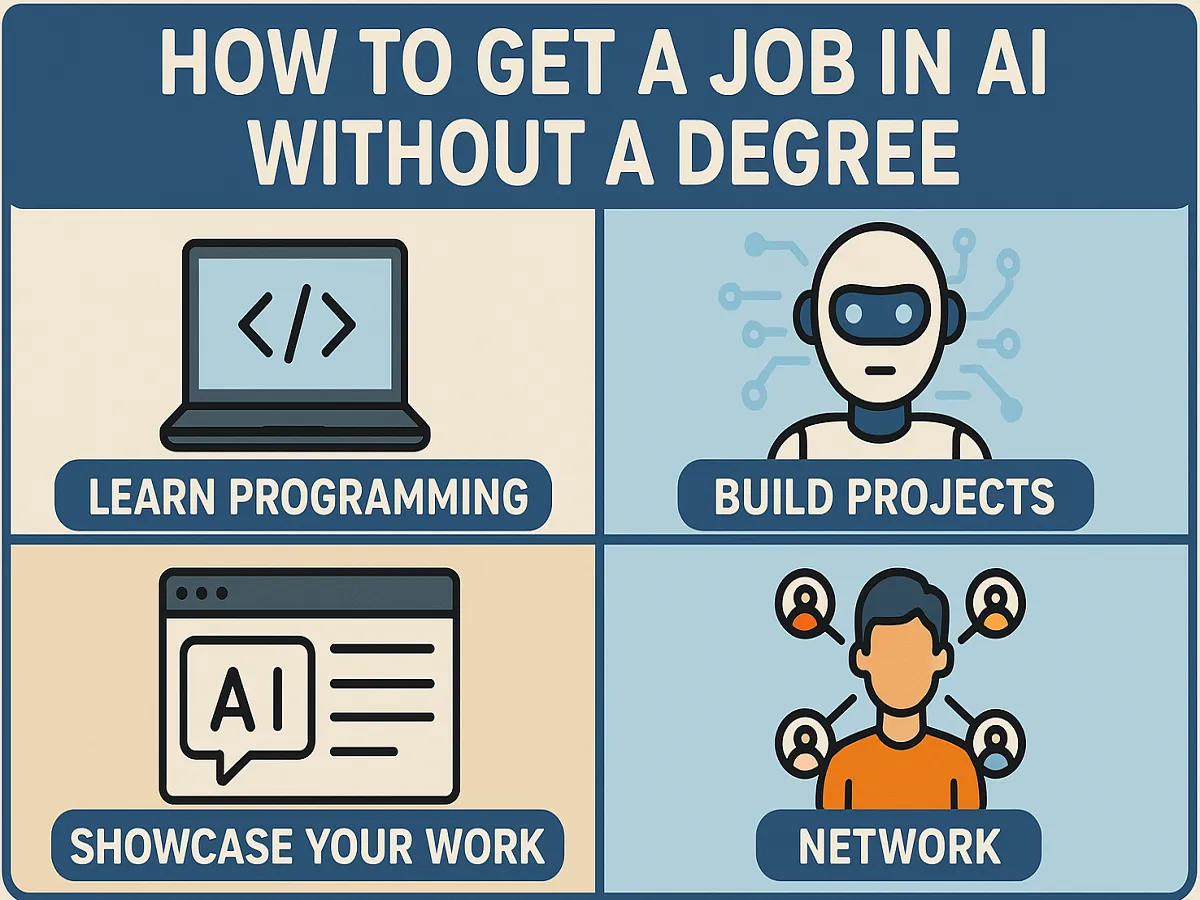You don’t need a fancy degree to break into AI, seriously. Although, there are some myths over reality about this tech.
Sure, it sounds like a field reserved for PhDs in lab coats, but that’s not the whole story. More and more companies are hiring based on what you can actually build, not what’s printed on a piece of paper.
Bootcamp grads, self-taught coders, and even former teachers have found real AI jobs. They didn’t rely on credentials. Instead, they came with working projects, strong Python skills, and the determination to solve real problems.
If you’re curious and willing to work, you have a chance. In this guide, I’ll show you how to go from “I know nothing” to “I just got hired”—no degree required.
Let’s dive in.
Key Takeaways
1. No degree? No problem. AI Skills and projects speak louder.
2. Learn by building, not just watching.
3. One strong project beats ten shallow ones.
4. Real experience comes from doing freelance, open source, or volunteering.
5. Show up, share openly, and connect. Your network opens doors.
Understand the AI Job Landscape
Artificial intelligence isn’t just about creating new algorithms. It’s also about using them. This includes cleaning messy data, adjusting models, and integrating tools into real products.
It’s about helping teams do something useful with AI. And the best part? Those jobs don’t always need a degree. In fact, here are real roles people like you are landing right now, no diploma needed:
- Junior Machine Learning Engineer – You’ll help build and deploy models (often using frameworks others created).
- AI Data Analyst – You turn messy data into a format that AI can learn from.
- Prompt Engineer – Yes, it’s a real job. You create, test, and improve prompts for better LLM results.
- AI Support Specialist – You assist sales teams or clients who are having trouble with AI tools.
- Computer Vision or NLP Technician – You use pre-trained models for tasks like document reading and image analysis.
- AI Product Coordinator – You connect engineers and business teams to clarify AI features.
- MLOps Assistant – You assist in automating tasks that keep AI models running smoothly.

It’s not just FAANG companies that need AI experts. Startups, healthcare tech firms, ecommerce brands, fintech apps, and marketing agencies also require people with AI skills.
They’re not asking, “Where did you go to school?” They’re asking, “Can you fix this? Can you build this? Can you make this work?”
So before you assume you’re not “qualified,” take a look at what’s actually out there. The gate isn’t guarded by academics, it’s wide open for anyone who shows up ready to contribute.
Build Foundational Knowledge (Self-Taught Path)
Many brilliant minds learned through late-night sessions fueled by curiosity and maybe too much coffee. With a solid foundation, you can accomplish great things. Here’s the key to making a meaningful impact:

– Python – Master the world of Python! This powerhouse loads data, sharpens models, and rectifies errors. Start with the basics, then wield Pandas, NumPy, and Scikit-learn to dominate.
– Math that clicks – Forget abstract theory. Focus on why math matters. Like how matrix multiplication makes neural networks tick, or why a confusion matrix tells you more than just “accuracy.” Visuals (shoutout to 3Blue1Brown) help way more than formulas.
– Data wrangling – Spoiler: 80% of real AI work is cleaning up garbage data. Learn to spot missing values, handle outliers, and turn spreadsheets into something an AI model won’t choke on.
– ML fundamentals – Understand the difference between “this model looks good” and “this model will actually work in the wild.” Learn about overfitting, bias-variance tradeoffs, and evaluation metrics through projects, not flashcards.
Now, where do you actually learn this stuff?
Start with Andrew Ng’s free Machine Learning course. It’s calm, clear, and cuts through the noise. Then jump into fast.ai, where you train real neural nets in lesson one (no PhD required). Google’s Machine Learning Crash Course is another no-nonsense option that respects your time.
YouTube? Absolutely. Krish Naik walks through real code like a patient mentor. 3Blue1Brown makes math feel like storytelling. And when you hit a wall (you will), Stack Overflow and Reddit’s r/learnmachinelearning have your back.
Oh, and books? Hands-On Machine Learning by Aurélien Géron is gold, but only if you’re coding along with every chapter.
Here’s the secret no one tells you: you don’t need to know everything before you start. Just know enough to launch your first small project.
Develop Practical Skills Through Projects
No one hires you for what you know. They hire you for what you’ve built.
Certificates gather dust. Resumes get skimmed in six seconds. But a live project? That’s proof you can actually do the work. In the AI world, especially without a degree, your portfolio is your resume.
So forget “studying more.” It’s time to build something real, even if it’s small, messy, or a little weird.
Start Simple (But Meaningful)
You don’t need to recreate ChatGPT. Try these instead:
– Predict used car prices using a public dataset
– Build a tweet sentiment analyzer that flags angry customers
– Create a basic image classifier that tells cats from dogs (yes, it’s cliché but it works)
– Fine-tune a small open-source LLM to answer FAQs for a fake business
The goal isn’t perfection. It’s demonstrating you understand the full cycle: ask a question → get data → clean it → train a model → evaluate results → share what you learned.
Do It Like a Pro (Even If You’re Not One Yet)
– Host your code on GitHub—but don’t just dump files. Write a clear README: What does it do? Why does it matter? How do I run it?
– Show your thinking. Include a short write-up (a blog post, a Jupyter notebook section, or even a LinkedIn post) explaining your choices, mistakes, and lessons.
– Deploy at least one thing. Use free tools like Streamlit, Hugging Face Spaces, or Flask on Render to put your project online. A live demo beats a screenshot every time.
Quality > Quantity
One strong, well-documented project is better than five incomplete ones. Employers focus on how you solve problems, not on the buzzwords in your repo name.
And here’s the kicker: you don’t need to come up with completely original projects. In the real world, most AI work involves taking existing solutions and applying them to new problems. This isn’t cheating – it’s just being professional.
So pick a tiny idea. Build it this weekend. Break it. Fix it. Share it. That’s how you go from “learning AI” to “doing AI.” And that’s how you get hired.
Gain Experience Without a Traditional Job
So you don’t have a degree, and you don’t have a “real” AI job yet. That’s okay. Because here’s the secret: experience isn’t just what’s on your W-2. It’s anything that proves you can deliver value with AI.
And guess what? You can start racking up that proof right now, even if no one’s paying you (yet).
Try Freelancing—Even Tiny Gigs
Platforms like Upwork, Fiverr, or Toptal are full of small, real-world requests:
– “Clean my messy sales data”
– “Build a simple classifier for customer emails”
– “Help me set up a basic chatbot”
Start small. Charge little (or even volunteer at first). Your goal isn’t income—it’s a testimonial, a case study, and confidence. One happy client can lead to your next opportunity or become a reference.
Jump Into Open Source
You don’t need to rewrite TensorFlow. But you can:
– Fix typos in documentation (yes, it counts!)
– Add examples to a library’s tutorial
– Report bugs with clear reproduction steps
– Contribute to beginner-friendly repos on Hugging Face, LangChain, or scikit-learn
These contributions show you can collaborate, read code, and communicate, skills every team needs. Plus, your GitHub profile starts looking active, not just academic.
Compete (Gently) on Kaggle
Don’t stress about ranking #1. Instead:
– Join a Getting Started competition
– Replicate someone else’s notebook, then tweak it
– Write a discussion post explaining what you learned
Consistent participation signals curiosity and grit—two things hiring managers notice.
Volunteer Your Skills
Nonprofits, local schools, or community orgs often drown in data but lack tech help. Offer to:
– Analyze donation trends
– Automate a manual reporting task
– Build a simple dashboard for program metrics
Not only do you gain experience—you also build a story. (“I helped a food bank predict demand using historical data” sounds way more compelling than “I did a tutorial.”)
Look for Apprenticeships & Micro-Internships
In today’s talent marketplace, giants like Microsoft and Google are paving the path for skills-first apprenticeships. Fresh startups are jumping on this exciting bandwagon, too!
Platforms such as LinkedIn, Otta, and TalentPath spotlight roles that proudly welcome candidates without degrees. Prepare to showcase your skills with open arms! Some even pay while you learn.
Build Your Personal Brand & Network
In a sea of self-taught learners, being good isn’t always enough. You also need to be seen.
But don’t panic, “personal branding” isn’t about becoming an influencer or posting daily reels. It’s about showing up as a real, helpful, curious human in the AI community. And the best part? You can start with just 20 minutes a week.
First, Clean Up Your Digital Front Door
Your LinkedIn profile is your handshake in the tech world.
– Ditch the generic headline like “Aspiring AI Enthusiast.” Try: “Building NLP tools to simplify customer support | Python | Transformers”
– Replace “Education” with a Featured section showcasing your best project, GitHub link, or blog post
– Write a short “About” section that tells a story—not a resume
Share What You’re Learning—Not Just What You Know
You don’t need to teach. Just reflect out loud.
– Wrote a script that finally worked after 3 days of debugging? Post it with: “Here’s what I missed…”
– Struggled with imbalanced datasets? Share your solution on LinkedIn or Medium
– Made a tiny Streamlit app? Tweet a screenshot with a one-sentence lesson
Show Up Where AI Folks Hang Out
– Join Discord servers like Hugging Face, LangChain, or PyData
– Lurk (then engage!) in subreddits like r/MachineLearning or r/LocalLLaMA
– Attend free meetups (check Meetup.com or Eventbrite)—many are virtual
– Comment thoughtfully on posts by people you admire (no “Great post!”, add value)
Ask for Coffee Chats—The Right Way
Cold-messaging can work if you’re specific and respectful:
Hi [Name], I loved your talk on fine-tuning LLMs. I’m building a similar project for nonprofit docs and hit a wall with token limits. Would you have 10 minutes to share one piece of advice?
Most people say yes, not because they owe you, but because you made it easy and human.
Remember: Consistency > Virality
You don’t need 10K followers. You need 10 people who know your work well enough to vouch for you. One thoughtful post a week. One genuine comment. One small project shared.
That’s how trust builds and referrals start. That’s how jobs appear before they’re even posted. So stop hiding in tutorial mode. Start sharing, connecting, and showing up. Your future employer is probably scrolling the same feed you are.
Ace the AI Job Hunt & Interviews
You have skills, projects, and a reputation. Now it’s time to get a real job. Old strategies won’t work. Sending many resumes or generic cover letters won’t get you hired.
First, Target the Right Companies
Forget “FAANG or bust.” Some of the best entry points are:
– Startups (they move fast, care about output, and often skip degree filters)
– AI-first tooling companies (like Hugging Face, Weights & Biases, or Replicate—they live this stuff)
– Non-tech companies with AI teams (banks, retailers, healthcare orgs—they’re hungry for practical talent)
– Remote-first firms (they often hire globally and prioritize skills over pedigree)
Use job boards like Wellfound (AngelList), Otta, LinkedIn (with “no degree required” filters), or even Twitter/X job threads.
Your Resume: Less Fluff, More Proof
– Lead with a “Skills & Projects” section, not education
– For each project, include a result or insight:
> “Fine-tuned DistilBERT to classify support tickets—reduced manual review time by 30%”
– Use real tools in your wording: “PyTorch,” “LangChain,” “Hugging Face,” “Pandas”, not just “machine learning”
– Keep it to one page. Recruiters skim. Make every line earn its place.
Nail the Interview—Without a CS Degree
Yes, you’ll likely face coding, ML, and generative AI questions. But here’s how to prep smart:
– LeetCode? Focus on easy/medium Python problems, especially data manipulation (think: groupby, filtering, merging)
– ML theory? Understand why, not just what. Be ready to explain:
– “How would you handle imbalanced data?”
– “What’s the trade-off between precision and recall in this scenario?”
– Project deep dives are your secret weapon. Expect:
Walk me through your sentiment analysis project. What would you do differently now? Be honest. Show growth.
Do Your Homework (Seriously)
Before any interview:
– Use the company’s product
– Read their engineering blog (if they have one)
– Check if they use specific frameworks (e.g., “They use Ray for scaling—mention your experience with distributed training”)
And Don’t Forget the Human Part
AI teams are eager to find clear communicators and collaborative spirits.
- Ask yourself: “What steps can I take to excel in this role within six months?”
- Share: “I’m not yet familiar with that tool, but I can build on my experience with X to learn.”
Confidence isn’t about knowing all the answers; it’s about your ability to discover them.
Keep Learning & Growing
AI is constantly changing. What’s hot today may be outdated in 18 months. Stay curious, connected, and keep improving to stay ahead.
Make Learning Part of Your Routine
Forget “study for 3 hours a day.” Instead, build micro-habits:
– Skim The Batch by DeepLearning.AI over morning coffee
– Listen to an AI podcast (like Latent Space or The TWIML AI Podcast) on your commute
– Spend 15 minutes on arXiv or Hugging Face blog a few times a week—just to see what’s new
Double Down on What Moves the Needle
Early on, you learned fundamentals. Now, go deeper where it matters for your goals:
– Want to work with LLMs? Dive into prompt engineering, RAG, and fine-tuning techniques
– Interested in computer vision? Play with YOLO, segmentation models, or video analysis
– Love data? Master feature engineering, A/B testing for ML, or data validation pipelines
Revisit Old Projects
Go back to that first sentiment analyzer or image classifier you built.
Now ask: “How would I rebuild this today?”
– Would you use a different model?
– Add better error handling?
– Deploy it with a nicer UI?
Stay in the Loop—Without Burning Out
Follow a few smart voices, not 100:
– Researchers: Yann LeCun, Andrej Karpathy, Emily Bender (for grounded takes)
– Builders: Hamel Husain, Rachel Thomas, Cassie Kozyrkov
– Newsletters: The Algorithm (MIT Tech Review), Import AI, Data Elixir
And Remember: Growth Isn’t Just Technical
The best AI practitioners also get better at:
– Explaining complex ideas simply
– Understanding business context
– Giving (and receiving) thoughtful feedback
Final Thoughts
Breaking into AI without a degree isn’t the exception; it’s becoming the norm for driven, hands-on learners. You don’t need permission, a pedigree, or perfect code. You need curiosity, consistency, and the courage to ship real work.
Build projects, solve problems, and make connections to reach your goal. The field wants doers, not just qualified candidates. Stop doubting.
Start building. Your AI career doesn’t begin when you get the job, it begins the moment you decide to show up. And you’re already here.

